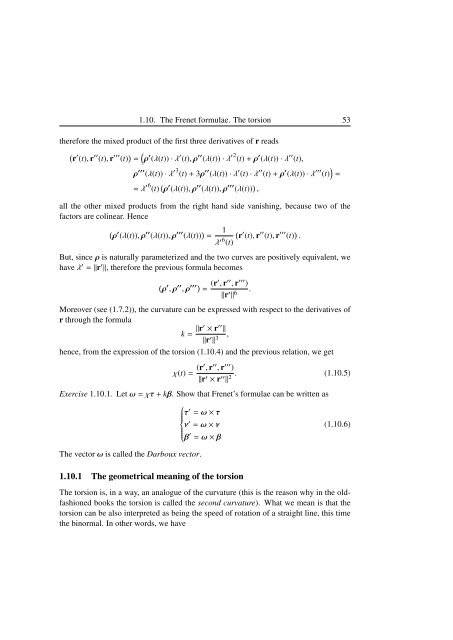Blaga P. Lectures on the differential geometry of - tiera.ru
Blaga P. Lectures on the differential geometry of - tiera.ru
Blaga P. Lectures on the differential geometry of - tiera.ru
Create successful ePaper yourself
Turn your PDF publications into a flip-book with our unique Google optimized e-Paper software.
1.10. The Frenet formulae. The torsi<strong>on</strong> 53<br />
<strong>the</strong>refore <strong>the</strong> mixed product <strong>of</strong> <strong>the</strong> first three derivatives <strong>of</strong> r reads<br />
� r ′ (t), r ′′ (t), r ′′′ (t) � = � ρ ′ (λ(t)) · λ ′ (t), ρ ′′ (λ(t)) · λ ′2 (t) + ρ ′ (λ(t)) · λ ′′ (t),<br />
ρ ′′′ (λ(t)) · λ ′3 (t) + 3ρ ′′ (λ(t)) · λ ′ (t) · λ ′′ (t) + ρ ′ (λ(t)) · λ ′′′ (t) � =<br />
= λ ′6 (t) � ρ ′ (λ(t)), ρ ′′ (λ(t)), ρ ′′′ (λ(t)) � ,<br />
all <strong>the</strong> o<strong>the</strong>r mixed products from <strong>the</strong> right hand side vanishing, because two <strong>of</strong> <strong>the</strong><br />
factors are colinear. Hence<br />
� ρ ′ (λ(t)), ρ ′′ (λ(t)), ρ ′′′ (λ(t)) � = 1<br />
λ ′6 (t)<br />
� r ′ (t), r ′′ (t), r ′′′ (t) � .<br />
But, since ρ is naturally parameterized and <strong>the</strong> two curves are positively equivalent, we<br />
have λ ′ = �r ′ �, <strong>the</strong>refore <strong>the</strong> previous formula becomes<br />
� ′ ′′ ′′′<br />
ρ , ρ , ρ � = (r′ , r ′′ , r ′′′ )<br />
�r ′ �6 .<br />
Moreover (see (1.7.2)), <strong>the</strong> curvature can be expressed with respect to <strong>the</strong> derivatives <strong>of</strong><br />
r through <strong>the</strong> formula<br />
k = �r′ × r ′′ �<br />
�r ′ �3 ,<br />
hence, from <strong>the</strong> expressi<strong>on</strong> <strong>of</strong> <strong>the</strong> torsi<strong>on</strong> (1.10.4) and <strong>the</strong> previous relati<strong>on</strong>, we get<br />
χ(t) = (r′ , r ′′ , r ′′′ )<br />
�r ′ × r ′′ . (1.10.5)<br />
�2 Exercise 1.10.1. Let ω = χτ + kβ. Show that Frenet’s formulae can be written as<br />
⎧<br />
τ<br />
⎪⎨<br />
⎪⎩<br />
′ = ω × τ<br />
ν ′ = ω × ν<br />
β ′ (1.10.6)<br />
= ω × β<br />
The vector ω is called <strong>the</strong> Darboux vector.<br />
1.10.1 The geometrical meaning <strong>of</strong> <strong>the</strong> torsi<strong>on</strong><br />
The torsi<strong>on</strong> is, in a way, an analogue <strong>of</strong> <strong>the</strong> curvature (this is <strong>the</strong> reas<strong>on</strong> why in <strong>the</strong> oldfashi<strong>on</strong>ed<br />
books <strong>the</strong> torsi<strong>on</strong> is called <strong>the</strong> sec<strong>on</strong>d curvature). What we mean is that <strong>the</strong><br />
torsi<strong>on</strong> can be also interpreted as being <strong>the</strong> speed <strong>of</strong> rotati<strong>on</strong> <strong>of</strong> a straight line, this time<br />
<strong>the</strong> binormal. In o<strong>the</strong>r words, we have












